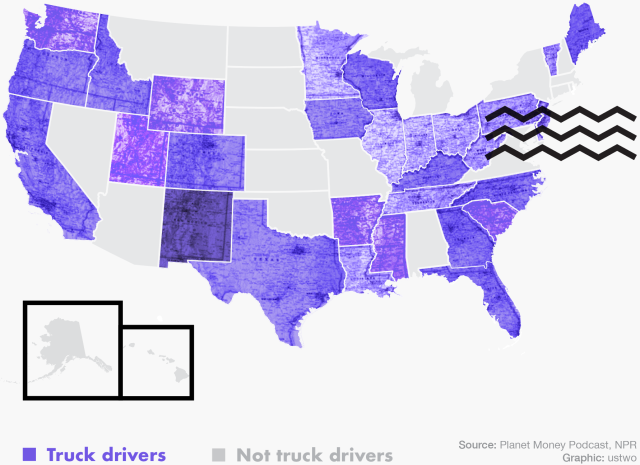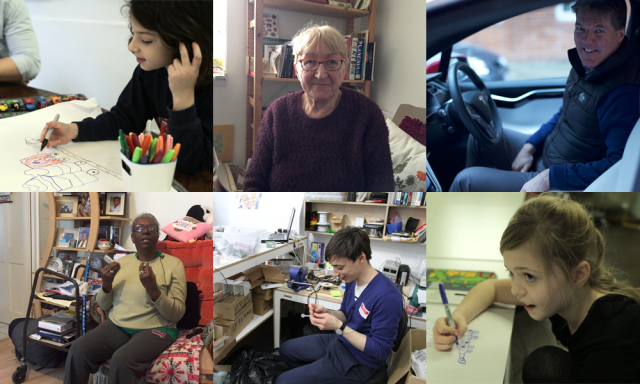What does Autonomy mean to you?
_ustwo Auto’s new book ‘Humanising Autonomy: Where Are We Going?’ explores how human centred design can help tackle barriers to Autonomous Vehicle adoption. In this series of blog posts we will be introducing major themes and insights from the book – which you can download in full here. _
A driverless car? I don’t think I would… I would panic. To be honest, I don’t know. But if I had no choice, maybe.
First encounters with autonomous vehicles (AVs) are often surreal or even scary experiences. Some people describe their experience as “spooky” or “like being in the future,” whereas others default to unprintable exclamations of both fear and wonder. There is probably no better demonstration of a first-time AV experience than that of a 70-year-old woman using Tesla’s Autopilot for the first time.
Our first experience taking a ride in a new-age Tesla P90D, driving along little lanes amid the Victorian buildings of London in a perfect cyberpunk juxtaposition, was similarly surreal. Our gracious guide was Rick Fish, a Tesla owner of many years, with a penchant for technology and education.
After a couple of Tesla Ludicrous Mode demonstrations, which showed off the car’s insane acceleration, Rick pulled into a quieter street with few pedestrians. “Let's try the Autopilot,” he said, and with the touch of a few buttons on the massive interface, we were off. Although he had his hands near the wheel, exercising caution, the car essentially drove itself for the next mile, sticking to the speed limits and with great lane discipline. Several brief encounters with pedestrians went perfectly – as they approached crossings the car slowed down to a stop to let them pass, almost respectfully (forgive us for anthropomorphising).
It was a surreal experience – after the initial amazement faded, it felt almost mundane. Only after getting out of the car and thanking Rick as we summoned an Uber did it hit us: we had just experienced the near-future of road transport. Three-tonne robots with varying degrees of autonomy in thought and action, based on underlying machine-level algorithms. And the technological complexity is only the beginning – it’s the human, legislative, and social aspects where things really get complicated. The technology may be inching ever closer, but given these other complexities, how near are we really to this future? What sort of basic needs does this future cater to? Is it even necessary? Do we want it?
Embedded content: https://vimeo.com/230365343
Fundamental human needs
Mobility is a fundamental human need. It’s enshrined in the basic human right of movement and even in the freedom of expression. As digital natives living in urban climes, we can easily be fooled into thinking that a golden age in mobility is dawning. Many experts have already claimed that driverless cars will be the biggest revolution in mobility since the automobile replaced the horse and cart.
We’re living in a techno-optimistic age fuelled by car sharing apps, improved public transport, investment in cycling infrastructure and on-demand services like Uber. Furthermore, what mobility entails and who is entitled to it has changed over time, rightly or wrongly. At a time of disruption, we need to take a fresh look at what technology can make possible for people, for all people.
Is this a ‘golden age’ for everyone? What do people actually want and need from this revolutionary new form of transport? Is it inclusive enough? Does it cut across technological understanding, socio-economic statuses and so on? Uber locks out many older people who don’t use smartphones, just as the first automobiles segregated the rich and the poor.
“The poor live downtown and the rich live in suburbs… transportation technologies play a crucial role in explaining this segregation. Because cars are so expensive, the poor live in cities so that they can use public transportation.”
Do we want future transportation technologies to continue to segregate? With AVs, cars become public transport – and there is a real inclusive opportunity here. For this technology to be truly adopted it must be accessible to all people, from the technophobes to the tech savvy, from the disadvantaged to the very rich.
These are just some of the questions that prompted us to conduct our own research. We studied academic trials, attended auto shows, watched countless documentaries and read endless articles. But most importantly, we spoke to people – the potential early adopters, the frequent users, even the sceptics. People from different backgrounds, with different needs, different ambitions and unique opinions about their thoughts and hopes for the forthcoming ‘revolution’ of driverless transport.
We conducted our own qualitative human centred research to unearth fundamental human mobility needs, to find out how these needs are being supported, and to see where driverless transport could really help. We found significant congruences in both research findings and our qualitative assessment, which confirmed that we are on the right track, albeit one that is relatively lightly trodden.
The insights we unearthed really opened our eyes to the many hidden and poorly-addressed needs that form this human barrier to the adoption of AVs. One such example is that of the relationship between driving and the elderly population. Driving is a complex task that requires a variety of skills, including physical, cognitive, behavioural and sensory-perceptual abilities. Declining health through age may force the elderly to stop driving and surrender their driving licenses (in the UK, driving ability is tested every three years for people over 70).
Driving for me is a positive activity… it keeps my mind fresh and alert
Studies have shown that giving up driving can have a significant impact on the quality of life for older people. Driving Cessation and Health Outcomes in Older Adults published in the American Geriatric Society reported that driving cessation was associated with declines in general health and physical, social, and cognitive function and with greater risks of admission to long-term care facilities and mortality. A meta-analysis based on their pooled data from five studies examining the association between driving cessation and depression revealed that driving cessation almost doubled the risk of depressive symptoms in older adults. Could improved mobility afforded by AVs thus alleviate some of the strain felt by bodies like the NHS who care for such people?
Mobility is crucial to the older people we spoke to, particularly to Francois and Darret (you can read more from their interviews later). You would imagine then that these driverless cars could truly benefit this population who are no longer able to drive and so have a decreased opportunity for mobility. Is this demographic even being considered in the development of the technology? Would the elderly actually feel comfortable getting into a vehicle without a human driver? What would they miss? What would make them feel more comfortable? Our research highlights a challenge whereby the elderly may not legally be able to drive, yet would be too scared to enter a driverless car. In addition, they could also suffer emotionally and even mentally from the loss of human interaction many isolated people enjoy from the likes of taxi and bus drivers. We have heard stories about cars being considered as ‘pets’ and an ‘absolute necessity’ – an area in which the driverless car could really help.
We also spoke to disabled people and wheelchair users, who told us of their need for discreetness and the independence to do as they please, without relying on others. One London-based wheelchair user in particular told us of his discomfort when buses have to take extended stops for him to board and for the bus to lower and extend a ramp, all the while emitting a “beeping” sound. Hardly discreet. The bus layout even dictates that he must enter from the middle of the bus, where the ramp is fitted, rather than the front of the bus as able-bodied people do; a clear physical segregation. This human need, not for physical accessibility, but for integration, discreetness and independence must be considered in AVs, or a poor user experience will surely result.
Take this wheelchair ramp for example:

This accessibility ramp was built after the building had opened. You can imagine that when the first few people climbed the steps to reach the entrance of the building, they thought the job was done. Then a wheelchair user approaches – and can’t enter the building. The architect then designs this snaking accessibility ramp to solve the problem. Sure, it functions – the wheelchair user can now enter the building. However, this solution has not taken the need for discreetness or integration into consideration. Much like the bus ramp anecdote told by our London resident, this ramp effectively segregates the wheelchair user from the able-bodied user; able-bodied users would enter from the steps on the right and wheelchair users enter from the ramp on the left. This is both segregating and indiscreet. Our users in Singapore and Mumbai talk of similar segregating retrofit solutions for those with disabilities within their transport networks. If the architect had considered these user needs from the beginning, they may have simply designed a ramp rather than a set of steps, which both able-bodied and wheelchair users could use to enter the building together.
There are other issues that go beyond the needs of the individual – the social and societal implications of the advent of autonomy. For instance, technological unemployment and its effect of shifting job markets to other fields or in the worst case, the dissolution of labour forces to make way for machine infrastructure. Are societies prepared for what AVs might bring in terms of jobs and also, perhaps more importantly, take away?
Daniel Susskind, from the economics wing of the University of Oxford writes in his probing paper A Model of Technological Unemployment about the well-recognised difficulty of accurately forecasting the future capabilities of machines.
Susskind says that the ‘task based’ approach of forecasting machine capabilities and its effects on the labour market is flawed, since those tasks are ever-changing as technology progresses. For instance, Autor et al noted in their 2003 paper The Skill Content of Recent Technological Change: An Empirical Exploration that the task of driving a car could not be readily automated, but then a type of driverless car appeared just two years later. Autor also noted that order-taking and table-waiting could not be readily automated, but later that year the US restaurants Chili’s and Applebee’s announced they were installing 100,000 tablets to allow customers to order and pay without a human waiter. We are perennial underestimators of technological progress and its effects – both a sobering and worrisome thought.

“As autonomous vehicle technology improves, it’s easy to imagine a world where these vehicles have no need for a human operator. This would leave the following people jobless: 180,000 taxi drivers, 160,000 Uber drivers, 500,000 school bus drivers, and 160,000 transit bus drivers, for a grand total of 1 million jobs (US).”
The widespread use of driverless vehicles, from cars, taxis and even trucks would not just affect people in driving related jobs – the ripples will be felt in other sectors too, like healthcare and insurance. For instance, insurance costs might increase for driven vehicles without driving aids or autonomous features. Similarly with costs for healthcare – driving per se could be viewed as a dangerous activity and might increase health care premiums (which is already the case for skiing or motorbiking).
The uptake of driverless vehicles is happening in other industries for financial and operational reasons. For example, Suncor Energy Inc last year announced that it would buy autonomous trucks from Komatsu Ltd for its oil-sands operations. Chief financial officer Alister Cowan said its plan is to move to an “autonomous truck strategy, which we should have fully implemented by the end of the decade.” He added “That will take 800 people off our site... At an average [total cost] of a few hundred thousand per person, you can see the savings we’re going to get from an operations perspective.”
Additionally, new, high-skilled technology jobs (software experts) may replace low-skilled driving jobs (bus drivers), says Barrie Kirk, co-founder and executive director of the Canadian Automated Vehicles Centre of Excellence (CAVCOE). Kirk expands that “from an economic point of view, I think it’ll all be fairly neutral, but that’s no comfort at all to the individuals who will lose their job… I’m a realist: it’ll be very challenging to take a 50-year-old bus driver and retrain him or her to be a software developer. There’s a tragedy there in the making and there will be social unrest.”

With that perspective, this decision for movement in jobs has been met with disapproval from the mining unions in Australia's Rio Tinto, who disagree with the economic and social benefits of autonomy as put forward by companies. In their view, the net result would be the loss of high-paying jobs and the introduction of mundane desk jobs for a highly skilled workforce. The ripple effects of autonomous workforces are already being felt beyond everyday traffic on the roads – how long till it affects everyone?
“The facts are workers will suffer significant losses as a result of this… It will be job losses and losses in income.”
Meanwhile, India’s transport and highways minister has already responded to this challenge of losing jobs by saying: “We won’t allow driverless cars in India. I am very clear on this. We won’t allow any technology that takes away jobs.” This is a bold but human sentiment, especially in a nation where widespread unemployment exists. But will it affect technological development and can the country continue to stay relevant in terms of vehicular innovation? Won’t AVs reduce accident risk and improve safety in a country rife with accidents? Only time will tell.
In order to probe this societal aspect of AVs, we have also spoken to people in driving-related jobs such as driving instructors, Uber drivers, and black cab and taxi drivers whose livelihood is based on both technology and their knowledge of the streets, the people they drive about and the regulations governing them. We’ve asked for their point of view on the nature of their present jobs and how they would change in the near future with an increased adoption of AVs and the changing nature of cities and technological infrastructure around them.
You never know with technology… something like the smartphone might come along for cars and I will not be a driving instructor anymore – they won’t need me.
Professional drivers, tech-savvy young professionals, children, the elderly, people with disabilities, driving enthusiasts – these are just some of the people we listened to and explored ideas with in an attempt to break through the insular and singular lens we as digital natives can sometimes be trapped inside. It’s this same singular lens that the automotive industry needs to break out of in order to identify the needs, desires and thoughts of real people. And it’s real people’s thoughts that we will echo and use to direct the conversation throughout our upcoming book.
So what did these individuals, our users, have to say? What follows is a holistic look at our user interviews, some of whom we also shadowed, which inform the basis of our approach and thinking throughout the book. You can also read each interview in detail on our Medium. We are indebted to these insightful people who generously spent time with us and who were such great sports in our conversations.

There’s more to transport than A to B
In the following paragraphs, we talk about some of the insights we gained from our user research.
Everyone we spoke to had preconceived ideas of what driverless cars were, thanks to existing early autonomous vehicles and, thanks, in part, to science fiction. The concept was not new to anyone, from seven year old Emily to 85-year-old Sorocco, but everyone’s interpretation varied, with each person projecting their own hopes and needs onto their understanding of the technology. Some people couldn’t grasp how the technology worked, while others worried it would work too well. None of them, nor indeed ourselves, know how this technology will integrate into our lives and/or the consequences – be they beneficial or dangerous.
The differing hopes for the technology stem from an infinite amount of personal biases cultivated through our unique experiences and the environments we live in, whether that’s London or Mexico City, Singapore or Mumbai. These varying needs will need to be discovered, understood and carefully considered if the technology is to be truly adopted. We will explore some of these needs in more detail in the upcoming book.
Functional & Emotional
Some needs were expressed by most of the people we spoke to and these are somewhat easier to understand. One particular and overwhelmingly consistent observation, was that people’s mobility needs span far beyond the functional – than that of simply getting from A to B – and include emotional requirements. These emotional needs go hand-in-hand with the functional needs of a journey.
DESIGN PRINCIPLE UNLOCKED:02. EMOTIONAL AND FUNCTIONAL NEEDSThere’s more to a journey than simply the functional need to get from A to B. Any journey includes many human and emotional needs such as comfort and social interaction.
Darret and Françoise, for example, and even Wanfy – a younger woman from Singapore we interviewed – enjoy and even cherish the human interaction with the driver of their chosen mode of transport; in this case a taxi or an Uber. Darret will even choose to use a taxi when she perhaps need not do, simply to have an uplifting conversation with the driver. People like Darret and Françoise, who are somewhat isolated due to disability, cherish their mobility so that they can leave their homes and be independent. When the day comes that Françoise is unable to retain her license to drive, AVs could give her back that independence she enjoys in her car. However, there are still some mental wellbeing gaps left by the current understanding of how AVs will work. By removing the driver, a person to interact with, in what is known as the third place, we risk increasing passengers’ sense of isolation, rather than improving it; in a world of AVs, Darret is now not only home alone, but possibly travelling alone too.
At the other end of the spectrum, by talking to people like Dave who owns a London black cab, we can understand the role beyond that of the driver – that of mediator and counsellor. Black cab drivers are also spotters of anti-social behaviour and conversation enablers. In their reactions to emergencies, such as passengers falling sick or a crime being committed, they become authority figures with the power to intervene. These skills are borne out of years of tacit knowledge gleaned while serving a city and meeting its many varied inhabitants, adapting quickly to situations both good and bad. This experience and behaviour is immensely hard to replicate in a robotic vehicle. These secondary roles will be sorely missed in the transition to autonomy if designers and technologists do not somehow include them.
Mass occupancy shared autonomous vehicles might help in this instance, by providing opportunities for interaction with others. However, our research shows that the relationship with the driver, and the associated “invitations” and “permissions” to engage with them (you have to negotiate destination and exchange money for example) differ depending on the mode of transport. For example, there are fewer invitations and permissions to engage in a bus or UberPOOL, when compared with a taxi.
Neuroscientist Matthew Lieberman in his book Social, stresses the importance of these human interactions, stating that our need to interact with other people is even more fundamental than our need for food and water. His peer, John Cacioppo, elaborates on this point: “Humans were not designed to be solitary creatures. We evolved to survive in tribes; the need to interact is deeply ingrained in our genetic code. So much so… that the absence of social connection triggers the same, primal alarm bells as hunger, thirst and physical pain.”
Driving also helps the elderly remain mentally active and mentally fit, so stopping driving has the opposite effect. Françoise herself said this was her core motivation to drive, fearing that someday she will not be able to retain her license. The proliferation of AVs might indeed have an adverse effect whereby opportunity to drive is restricted or made difficult and therefore limiting options for the elderly to remain mentally active. In an ageing population such as that of London and Singapore, this could become a growing problem.
On a lighter note, by removing the driver, we also remove some of life's serendipitous moments. Wanfy speaks of her fondness for such quirks – being offered a pen by an Uber driver, or having a conversation with that bus driver she sees every other day. Of course, for others, the thought of never having to speak to another stranger ever again might fill them with joy!
Our users also expressed many emotional needs that were satisfied by the actual act of driving. Rick and Neil both speak about their sense of freedom while driving, and Neil, in particular, believes there is an innate connection in the “reptile part” of his brain that compels him to drive – the roar of the engine, putting your foot down and “being naughty”.
All of the children we interviewed said they would one day like to learn to drive because they like the idea of freedom. And that’s also something both Neil and Rick would miss, should driving become prohibitively expensive or overly-regulated as some people suggest. Reasons like these, among others, suggest that the utopian or dystopian vision of a fully automated road network will never materialise, the roads forever cohabited by autonomous cars and driven cars.
Trust and safety
Naturally, one of the most important things to get right in AVs is safety. These vehicles must be incredibly safe, in fact safer, statistically and practically than manually driven cars on the roads today if they’re to be of much use to us. This is something that is clearly on people’s minds with the term “safe” being brought up by almost all of our users.
While everyone wanted AVs to be safe, their interpretation of the word and therefore the nature of trust in the vehicle or the system changed from person to person. While Samuel, 13, had no trust in the driving capabilities of the vehicle, fearing for his physical safety, sentiments shared by the other children and elderly users, the young to middle-aged adults didn’t question the physical safety of the vehicle at all. Yeva, 6, sees the driverless car like a malfunctioning robot, running amok around town, striking fear into passengers, fellow motorists, pedestrians, and even Italians! In fact, she thinks that even the sheer amazement experienced by those witnessing a driverless car would cause accidents. Rick, on the other hand, believes that the AV “has your back” and is totally safe. Interestingly, Yeva would not put her children in an AV for fear of their safety, while Rick looks forward to a time where his children don’t have to drive and instead can be driven around by much safer autonomous cars.
Despite the confidence demonstrated by Rick and others, the question of who is to blame or liable when things go wrong came up many times, which is rather telling. It seems that most people understand that AVs are not perfect and will indeed fail from time to time. A sense of moral apprehension as to the negative consequences to third parties followed these questions.
On the flip side, the same people who trusted the driving capabilities and physical safety of the vehicle itself, did not trust the safety of their personal information held by the system. This worry never crossed the minds of the young and elderly users. Ironically, the tech savvy users, for example, Neil with his Human Machine Interaction agency or Rick with his three Teslas, understood the technology well enough to grasp the fundamental operational necessity for AVs to hold personal information, while at the same time feeling nervous about the security of that data.
All of this boils down to one thing – trust. Trust is one of the core human needs that the autonomous vehicle must establish and defend if the technology is to be adopted at all. This unlocks one of the most essential design principles:
DESIGN PRINCIPLE UNLOCKED:03. ESTABLISH TRUST EARLY, MAINTAIN INDEFINITELYIn order to facilitate early adoption and to lessen anxiety associated with new technologies, we need to establish trust between the AV and the humans it interacts with.
Cultural differences
It’s interesting to see how this question of trust changes from city to city. While our users in the UK and India don’t have much faith in the transport network, perhaps brought on by the historical experience of failing systems (passengers of UK’s Southern Rail and Indian Rail will understand), our user in Singapore spoke of great trust in their own transport system. In Singapore all trains are automated, very rarely go wrong and are therefore heavily trusted and heavily used. Mexico City is another story – Sorocco was urged by her family to stop driving there because of the threat of robbery and even kidnapping when cars are stationary in traffic. But with no driver on board, passengers in autonomous vehicles in Mexico City could potentially be more vulnerable than ever. Though human needs seem to transcend cultural differences, this city-specific threat could be another barrier to adoption.
The importance of understanding people
Ethics, liability, policies, implications to cities and society as a whole, questions and concerns about the technology’s capabilities, trust, brands, what people do if they’re not driving – these are just some of the themes that came up in our user interviews. These themes are congruent with much of the academic and desk research we have been doing, as well as our own real-world experiments.
For the technology to be adopted, it must be trusted, and to do that, all of these human factors – all of these themes and questions – must be taken into consideration. What we want to do is understand each one from the unique perspectives of the real users, rather than working on assumptions made in design workshops or in university laboratories. This is an incredibly important step in designing not just for AVs, for mobility, but for everything that is used by humans. The first step in user-centred design is to understand people and their needs for that product or service. In this case, that is people’s mobility needs for the autonomous vehicle.
We want to address all of these user concerns from a user perspective and a human perspective, applying user-centred design methods and thinking. By doing this we hope to help negate the risk of under-serving the practical, as well as the emotional, human needs of transport and mobility. As we put it in our first book, there is room for beauty and brains.
It’s not all doom and gloom. Technology optimists, while nervous of the safety of their data, look forward to the day of autonomous vehicles, not just so they can sleep on the ride, but also so they can get their hands on a new and exciting piece of kit – like a child opening a Nintendo 64 at Christmas. While the elderly and less mobile fear for their physical safety, they will adopt the technology if it means they can remain mobile and independent. The fear of the technology is matched only by the excitement for it, and sometimes the ability it affords to overcome a serious need or problem can outweigh any concerns.
At the end of the day, a successful AV user experience will be the one that you connect with emotionally, not just functionally. How to form that connection is a key challenge we’ll attempt to tackle in our upcoming book.
These are the themes that we cover in the following sections of this book, looking at each from a uniquely human perspective. If you're interested to hear more of our thinking download a free copy of the book here.
